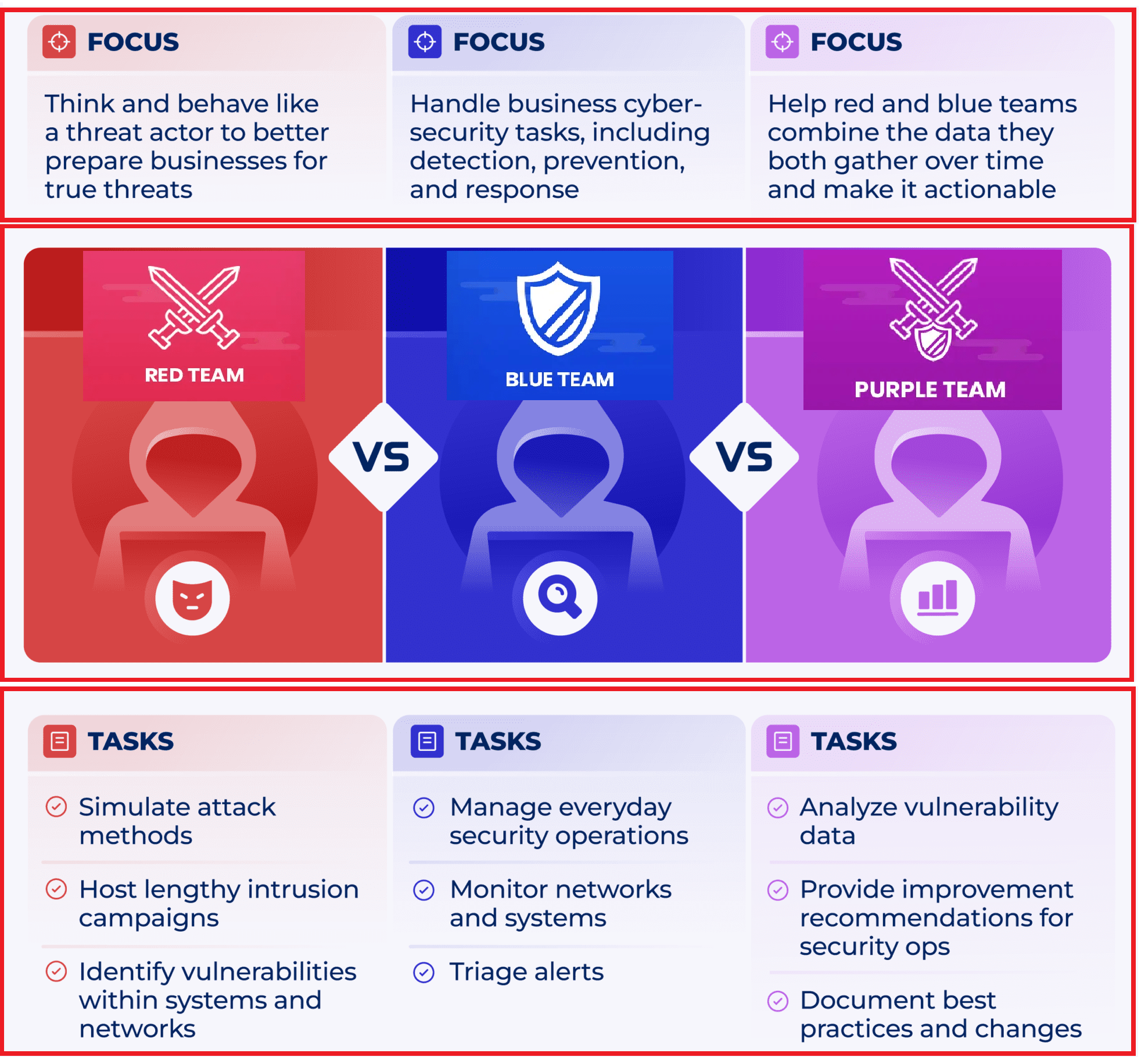Cybersecurity professionals constantly need to stay ahead of potential threats. Red teaming, an exercise where security experts simulate real-world attacks to test an organisation’s defences, requires a specialised toolkit. This comprehensive guide examines the most effective top Red Team Tools by category currently available, categorised by their function in the attack lifecycle. Red teaming involves authorised simulated attacks against an organisation’s security systems to identify vulnerabilities before malicious actors can exploit them. Having the right Red Team tools by category in your arsenal is crucial for conducting thorough assessments that reveal potential security gaps. Red, Blue, Purple, and White teams play distinct roles in improving an organisation’s security posture. Red teams simulate attacks, Blue teams defend against them, Purple teams collaborate to bridge the gap between offense and defense, and White teams oversee the entire process, ensuring ethical and legal boundaries are respected.
Table of Contents
Top Red Team Tools Reconnaissance
The initial phase of any red team operation involves gathering intelligence about the target environment. These reconnaissance tools help map out potential entry points:
| Category | Tool | Description |
|---|---|---|
| 🔍 RECONNAISSANCE | RustScan | An extremely fast port scanner that identifies open services on target systems |
| NmapAutomator | Automates the Nmap scanning process for comprehensive network enumeration | |
| AutoRecon | Performs automated reconnaissance to save valuable time | |
| Amass | Discovers subdomains and network infrastructure related to target organisations | |
| CloudEnum | Specifically designed for enumerating public cloud services | |
| Recon-NG | A full-featured reconnaissance framework for web-based information gathering | |
| AttackSurfaceMapper | Creates a visual representation of potential attack vectors | |
| DNSDumpster | Web-based DNS reconnaissance tool for discovering DNS records |
Initial Access Red Team Tools
Once reconnaissance is complete, red teams need tools to gain initial access to target systems:
| Category | Tool | Description |
|---|---|---|
| 🔑 INITIAL ACCESS | SprayingToolKit | Facilitates password spraying attacks against various services |
| o365Recon | Specifically targets Office 365 environments for potential vulnerabilities | |
| Psudohash | Creates targeted wordlists for password attacks | |
| CredMaster | Manages credential attacks with features to avoid detection | |
| DomainPasswordSpray | Efficiently tests password lists against Active Directory | |
| TheSprayer | Another password spraying tool with advanced evasion capabilities | |
| TREVORspray | Designed for Microsoft Online accounts with focus on preventing account lockouts |
Delivery Mechanisms Red Team Tools
These tools help red teams deliver payloads to target systems:
| Category | Tool | Description |
|---|---|---|
| 📧 DELIVERY | o365AttackToolKit | Specialised for Office 365 environments |
| EvilGinx2 | Advanced phishing framework that can bypass multi-factor authentication | |
| GoPhish | Open-source phishing toolkit for simulating phishing campaigns | |
| PwnAuth | OAuth framework for testing authentication security | |
| Modlishka | Reverse proxy for advanced phishing assessments |
Command and Control Frameworks Red Team Tools
Once access is gained, these command and control (C2) frameworks help maintain persistence:
| Category | Tool | Description |
|---|---|---|
| 🖥️ COMMAND AND CONTROL | PoshC2 | PowerShell-based C2 framework for Windows environments |
| Sliver | Cross-platform implant framework supporting multiple protocols | |
| SILENTTRINITY | Post-exploitation C2 leveraging Python and .NET | |
| Empire | PowerShell and Python post-exploitation framework | |
| AzureC2Relay | Uses Azure services for command and control | |
| Havoc C2 | Modern, feature-rich C2 framework | |
| Mythic C2 | Collaborative, multi-platform C2 framework |
Credential Dumping Red Team Tools
These tools help extract credentials from compromised systems:
| Category | Tool | Description |
|---|---|---|
| 🔐 CREDENTIAL DUMPING | MimiKatz | The classic tool for extracting plaintext passwords from memory |
| HekaTomb | Extracts credentials from large Active Directory environments | |
| SharpLAPS | Retrieves LAPS passwords when given the appropriate rights | |
| Net-GPPPassword | Finds and decrypts Group Policy Preference passwords | |
| PyPyKatz | Pure Python implementation of MimiKatz |
Privilege Escalation Red Team Tools
Once inside a system, these tools help escalate privileges:
| Category | Tool | Description |
|---|---|---|
| ⬆️ PRIVILEGE ESCALATION | SharpUp | C# port of PowerUp privilege escalation tool |
| MultiPotato | Combines multiple potato attacks for privilege escalation | |
| PEASS | Privilege Escalation Awesome Scripts Suite | |
| Watson | Enumerates missing patches and potential vulnerabilities | |
| Bat-Potato | Next-generation potato privilege escalation technique |
Defence Evasion Red Team Tools
To remain undetected during assessments, these tools help evade security controls:
| Category | Tool | Description |
|---|---|---|
| 🛡️ DEFENCE EVASION | Villain | Windows and Linux backdoor generator and multi-session handler |
| EDRSandBlast | Tool to unhook EDR security products | |
| SPAWN | Cobalt Strike Beacon Object File for improving operational security | |
| NetLoader | Loads binaries from a remote server into memory | |
| KillDefenderBOF | Disables Windows Defender (for authorised testing only) | |
| ThreatCheck | Identifies signatures that security tools flag | |
| Freeze | Suspends processes to evade memory scanning | |
| GadgetToJScript | Generates JScript that loads .NET Assemblies from memory |
Building an Effective Red Team Tools by category
When assembling your red team toolkit, consider these factors:
- Operational requirements: Choose tools aligned with your specific assessment goals
- Target environment: Select tools appropriate for the systems you’ll be testing
- Stealth capabilities: Consider how easily tools can be detected by security controls
- Documentation and community support: Tools with strong communities often receive updates and have better troubleshooting resources
- Legal and ethical considerations: Always ensure proper authorisation before using these tools
Best Practices for Red Team Assessments
To maximise the effectiveness of your red team operations:
- Maintain proper authorisation and documentation for all activities
- Establish clear rules of engagement before beginning assessments
- Implement secure channels for communicating findings
- Prioritise discovered vulnerabilities based on risk
- Provide actionable remediation recommendations
Conclusion
Red teaming remains one of the most effective methods for testing an organisation’s security posture. The tools listed in this guide represent the current state of the art for conducting professional red team exercises. By understanding and appropriately using these tools, cybersecurity professionals can better identify vulnerabilities, improve security controls, and ultimately strengthen their organisation’s defence against real-world threats.

